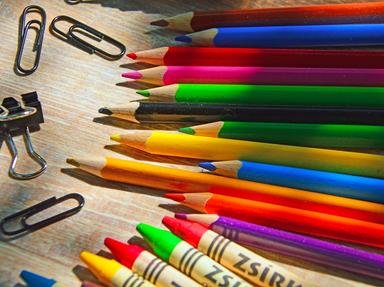Quiz Answer Key and Fun Facts
1. It's hard to imagine a kindergarten craft that doesn't include construction paper in some way. It's inexpensive, it's brightly coloured, it's easy to cut with those dull rounded scissors.
When what we now consider construction paper was first marketed to schools, in the late 1800s, what persuasive claim was made about, specifically, the green paper?
2. An essential ingredient of almost all kindergarten and school craft projects is glue. These days, most schools seem to use white glue, but when I was a child in the 1960s, we had bottles of mucilage.
What is mucilage made from?
3. It wouldn't be the Christmas tree of a family with young children, without a few salt dough ornaments - the impression of a tiny hand, maybe, or cookie cutter stars or candy canes.
Will craft items made with salt dough go bad or mouldy over time, or do they last forever?
4. Your kindergartener will most likely use yarn in her crafts as a decorative material, or to tie together different parts of the object. An older child, however, can actually make an object with yarn, through weaving, knitting, crochet, embroidery....
What is the name of the type of yarn that has little flecks of a different colour interspersed throughout?
5. No child's craft is complete, unfortunately, without a heavy sprinkling of glitter. It goes everywhere, sticks to everything, gets in your eyes and up your nose - but kids love it.
True or false: The first recorded use of glitter is on Christmas cards in Germany in the 1870s.
6. Your kindergartener has brought home a Christmas star, made of flat wooden sticks with rounded ends, heavily glued and well-glittered.
What's the informal name, in North America, for these flat pieces of light wood that so often find themselves being used in children's crafts?
7. Another essential item in any kindergarten teacher's supply closet is the empty paper towel or toilet paper roll. These light cardboard tubes can be used in many ways, from making "candles" to making "flutes".
Around when did toilet paper on a roll first appear?
8. Once that lovely craft item has been assembled, it needs to be painted!
Which of these paint types are you LEAST likely to find in a kindergarten classroom?
9. It's hard to imagine children's arts and crafts without wax crayons.
Which was the leading brand of wax crayon in North America (and much of the rest of the world) through the twentieth century?
10. And here's something hanging from the Christmas tree, made by your kindergartener - it's a .... well, I'm not sure exactly what it is. A star? An angel? Oh, of course, it's a reindeer, how silly of me not to see that. To be fair, papier-mâché is a difficult medium for small fingers, and it's hard to get the details just right.
Which of these is a traditional binding material for papier-mâché that you are most likely to find in a kindergarten classroom?
Source: Author
agony
This quiz was reviewed by our editing team before going online.
Any errors found in FunTrivia content are routinely corrected through our feedback system.
